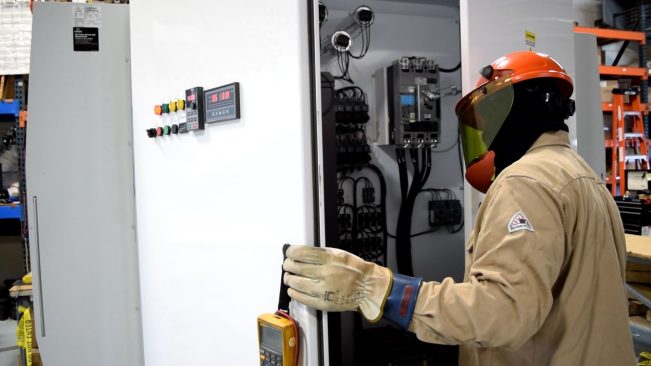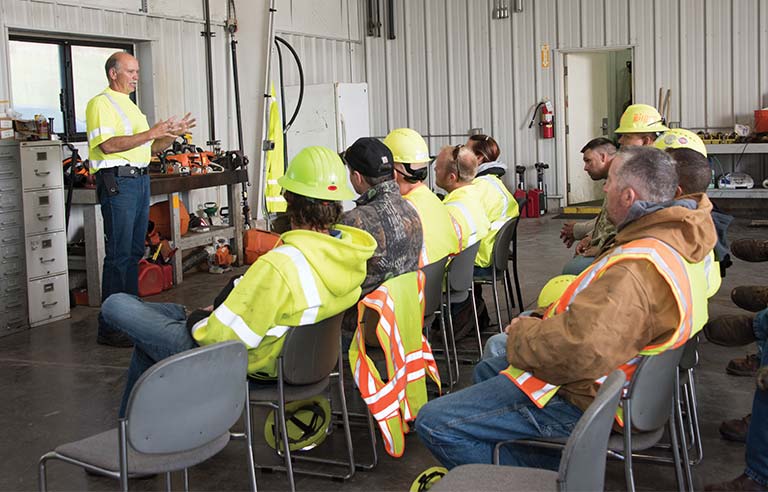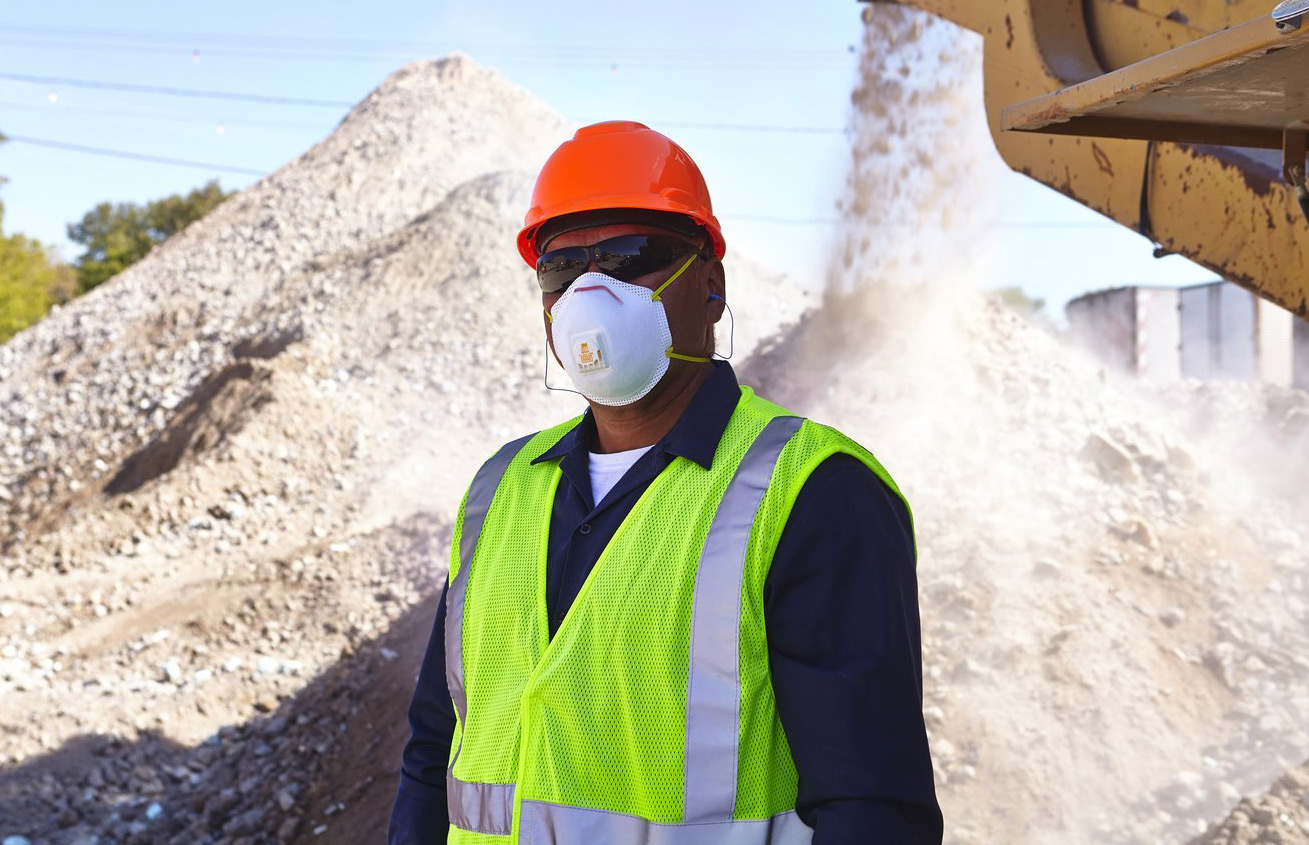The dangers of arc flash are present in numerous areas of municipal operations. We might think of them as solely an electrical department issue, but arc flash can cause severe injuries to anyone working on or near electrical equipment. For this reason, OSHA updated their Electric Power Generation, Transmission, and Distribution standard (1910.269) and Electrical Protective Equipment standard (1910.137).
department issue, but arc flash can cause severe injuries to anyone working on or near electrical equipment. For this reason, OSHA updated their Electric Power Generation, Transmission, and Distribution standard (1910.269) and Electrical Protective Equipment standard (1910.137).
Arc flash is a phenomenon where a flashover of electrical current leaves its intended path and travels from one conductor to another or the ground. The cause of this can be any of the following:
- Dust
- Dropped tools
- Accidental touching
- Material failure
- Condensation
- Corrosion
- Faulty installation
Electrical transformers and switchgear need to have arc flash warning labels. These labels need to be in accordance with NFPA 70 – National Electric Code, Article 110.16, to warn qualified persons that a potential arc flash hazard is present. This will allow personnel to select proper personal protective equipment (PPE) following acceptable safe work practice standards (see 1910.137 above).
The OSHA standard 1910.137 on PPE for electrical work requires that those employees working in areas of potential electrical hazards be provided with and use electrical protective equipment, including:
- Eye and face protection
- Gloves
- Helmets
- Flame-resistant (FR) clothing
- Rubber insulated blankets
- Matting and rubber insulated gloves and sleeves
Arc flash signage should denote the warning of electrical injury first. Additional ways to protect employees include:
- A solid lock-out/tag-out program
- De-energizing circuits
- Insulation
- Guarding
- Barricades
- Ground fault circuit interrupters (GFCIs)
- Work practices that include training and PPE
- Grounding of equipment
Equipment evaluations for arc flash and shock protection should be standard practice. The evaluations will identify approach and protection boundaries (limited, restricted, and prohibited) to determine what PPE is necessary to keep the employees safe.
According to the OSHA Personal Protective Equipment Standard 1910.132, it is up to the employer to conduct a job hazard analysis to identify the workplace exposures and hazards present. From there, they can determine what PPE is necessary to protect the workers from threats that can't be removed through elimination, substitution, or other engineering and administrative controls. The employer is required to provide the appropriate PPE for the job and train the worker on how to use, store, and maintain the equipment.
Since the inception of the Comp Alliance, the goal of the risk management department has been to identify potential workplace hazards likely to contribute to employee injuries and assist our members in removing such hazards. Perhaps the best method to accomplish this goal is to provide safety training for applicable municipal staff. In a number of circumstances, all municpal staff have to be trained on a variety of safety topics. Sometimes annual training is required, or routine training to staff required to display a competancy in a job function. Members can view a recently posted training chart by visiting www.compalliance.org and clicking on the Municipal Employee Training Requirements Article under the Latest News section.
hazards likely to contribute to employee injuries and assist our members in removing such hazards. Perhaps the best method to accomplish this goal is to provide safety training for applicable municipal staff. In a number of circumstances, all municpal staff have to be trained on a variety of safety topics. Sometimes annual training is required, or routine training to staff required to display a competancy in a job function. Members can view a recently posted training chart by visiting www.compalliance.org and clicking on the Municipal Employee Training Requirements Article under the Latest News section.
The focus of our risk management team is to provide high-quality, informative training programs aimed at making member attendees smarter about safety in the workplace. The OSHA Act of 1970 introduced the country to national safety standards and a major, all-encompasing safety message in their General Duty Clause. Their General Duty Clause says that employers must furnish its employees employment and a place of employment which are free from recognized hazards that are causing or likely to cause death or serious physical harm to its employees. The best method to manage and protect employees from these recognized hazards is to provide informative safety training programs specific to their risks (i.e. Lock-out/Tag-out, Personal Protective Equipment, Workplace Violence, and many others).
Not all safety training is created equal. Just providing the bare minimum to meet current standards is not likely to prevent serious employee injuries. The goal of your safety training should be to provide exceptional information to staff and spotlight employee safety, incorporating a strong focus on hazards that exist in the workplace and improving employee knowledge to control those hazards. Training that simply “checks the box” for compliance purposes only, will likely be viewed as bland and basic by staff, they will appear disinterested, fail to gain adequate knowledge of the risks associated with their positions, and is unlikely to provide staff with any safety clarity.
Cultivating safety at your municipality includes improving safety training programs. Trainings that focus strongly on employee awareness of hazards, prioritizing controls for those hazards, and explains incident reporting procedures to account for unsafe conditions, will certainly improve the operational safety culture within your organization. Create learning opportunities your staff can appreciate and goes beyond simply accounting for people in attendance. The Comp Alliance risk management department focuses our training on staff development, improving their ability to recognize hazards and remove or avoid them. This, afterall, is the primary focus of a dynamic safety program – improving the safety skills of staff so that workplace injuries do not occur which could negatively impact your work environment.
Contact your Comp Alliance loss control professional or the Director of Loss Control, Robert Blaisdell at (518) 330-8591 or This email address is being protected from spambots. You need JavaScript enabled to view it. for more details on our safety training offerings.
The thought of summer camp in the not-too-distant future will likely bring smiles to many faces. After all, jumping in a pool, getting messy with arts and crafts, and running around a soccer or baseball field is probably a welcome break from nonstop online games, too much time spent on social media, and endless Zooming. Camp is a great opportunity for children and teens to socialize with friends this upcoming summer. Many of our members have adapted during this pandemic and the summer of 2021 will continue to present some challenges for children and staff.
arts and crafts, and running around a soccer or baseball field is probably a welcome break from nonstop online games, too much time spent on social media, and endless Zooming. Camp is a great opportunity for children and teens to socialize with friends this upcoming summer. Many of our members have adapted during this pandemic and the summer of 2021 will continue to present some challenges for children and staff.
All summer staff are considered employees of a municipality, and therefore required by New York State to undergo annual training on Bloodborne Pathogens, Right to Know, Workplace Violence and Anti-Harassment. Please ensure that your summer staff receives annual training on these topics. It is also recommended lifeguards and other outdoor staff, (such as camp counselors) obtain training on sun safety and vector borne diseases and other related topics. Please see https://www.compalliance.org/comp-alliance-academy.html for more details.
The challenges facing staff this year will be unique to the circumstances surrounding the on-going pandemic. We are not out of the woods yet with this deadly virus. Having an up-to-date safety plan that deals with the virus, in addition to the normal summer recreation exposures, will keep your staff on the same page with all safety procedures. All employees should receive training on the plan during initial orientations. Since some of these locations have not been used throughout the year make sure first aid kits, medical office supplies, generic medication and sanitation equipment are adequate and replenish low inventory.
Camp administrators may consider implementing several strategies to encourage behaviors that reduce the spread of COVID-19. Social distancing should be maintained where possible and masks should be worn as well. Require summer staff to wear masks during their shifts and breaks, except when eating and drinking. Use of shared objects such as art supplies, mats, games etcetera should be limited when possible, or cleaned between use.
Educate staff, campers, and their families about when they should stay home and when they can return to camp. Actively encourage employees and campers who are sick or have recently had a close contact with a person with COVID-19 to stay home. Of course, staff and campers should stay home if they have tested positive for or are showing COVID-19 symptoms.
These safety recommendations will make this upcoming summer a safe and productive season for all staff and attendees.
According to the Occupational Safety and Health Act, employers have a responsibility to ensure employees are provided a safe working environment. Addressing sun safety is an essential part of this. When it comes to health in the workplace, prevention is far better than the cure.
The most effective way for employers to protect employees from contracting skin cancer is to provide sun safety measures in the workplace. Implementing a comprehensive sun protection program can prevent sun-related injuries and reduce the suffering and costs associated with skin cancer. Look to have employees spend some time in the shade, away from direct sunlight, wear protective clothing, and apply sunscreen routinely, while working outdoors.
Millions of U.S. workers are exposed to heat in their workplaces. Although illness from exposure to heat is preventable, every year thousands become sick from occupational heat exposure, and some cases are fatal. Most outdoor fatalities (50% to 70%) occur in the first few days of working in warm or hot environments because the body needs to build a tolerance to the heat gradually over time – this process is called acclimatization.
Occupational risk factors for heat illness include heavy physical activity, warm or hot environmental conditions, lack of acclimatization, and wearing clothing that holds in body heat. Hazardous heat exposure can occur indoors or outdoors, and can occur during any season if the conditions are right, not only during heat waves. Employees that work outdoors in warm weather, work near heat sources such as ovens, fires, or hot tar, perform strenuous physical activity, and/or wear heavy or non-breathable work clothes have a greater risk of heat related illness.
Several heat-related illnesses can affect workers. Some of their symptoms include:
Heat stroke – Confusion, slurred speech, unconsciousness, seizures, heavy sweating or hot, dry skin. Very high body temperature
Heat exhaustion - Fatigue, irritability, thirst, nausea or vomiting, dizziness or lightheadedness, heavy sweating, elevated body temperature or fast heart rate
Heat cramps - Muscle spasms or pain. Usually in legs, arms, or trunk
Sunburn - Painful, red and warm skin. Blisters on skin
Heat rash - Clusters of red bumps on skin. Often appears on neck, upper chest, and skin folds
The best engineering controls to prevent heat-related illness is to make the work environment cooler and to reduce manual workload with mechanization. Installing air conditioning in certain areas such as break rooms could prevent heat-related illness. Cooling fans and increased overall ventilation could assist employees to cool-down. Usage of mechanical equipment to replace manual labor could decrease the chance of heat-related illness.
Some worksites cannot be cooled by engineering controls. At those locations, employers should modify work practices when heat stress is too high to work safely. Modifying work schedules and activities for workers who are new to warm environments will reduce heat stress. Requiring mandatory rest breaks in a cooler environment and scheduling work at a cooler time of the day if possible could avoid heat-related illness. Rotate job functions between workers to minimize exertion and heat exposure. Ensure that workers drink an adequate amount of water or electrolyte-containing fluids and avoid drinking hot beverages during lunch and afternoon breaks.
The key to the prevention of worker illness due to excessive sun and heat exposure is to provide a safe working environment which is continuously monitored for worker safety.
May 2020 Comp Alliance Safety Bulletin
For the past two months, the majority of our municipal operations have engaged in reduced roles, as th e State of New York has been on PAUSE criteria. Soon perhaps, we can look to establish an expansion in operations, welcoming back employees and increasing established workloads. The Comp Alliance Risk Management department is here to assist our municipal members in establishing new guidelines for re-opening services while easing social isolation in getting employees back to work. NYS has established a “Phased Plan to Re-Open New York” and we’ll review this plan, municipal requirements from the plan and our loss prevention recommendations as well, all for the protection of your employees and the public health.
e State of New York has been on PAUSE criteria. Soon perhaps, we can look to establish an expansion in operations, welcoming back employees and increasing established workloads. The Comp Alliance Risk Management department is here to assist our municipal members in establishing new guidelines for re-opening services while easing social isolation in getting employees back to work. NYS has established a “Phased Plan to Re-Open New York” and we’ll review this plan, municipal requirements from the plan and our loss prevention recommendations as well, all for the protection of your employees and the public health.
New York State has been under a PAUSE order for the past two months. This order has identified controls for essential and non-essential operations in an effort to reduce the impact of the coronavirus on the state. Parts of the PAUSE order included closing non-essential business, non-essential gatherings of any size are cancelled or postponed, when in public individuals must practice social distancing of at least six feet from others and wear masks, improved cleaning and sanitizing procedures, sick individuals should not leave their home unless to receive medical care and only after a tele-health visit to determine if leaving the home is in the best interest of their health, among others.
These PAUSE orders are due to be scaled back beginning May 15th. The state has issued re-opening guidelines for regions around the state: https://www.governor.ny.gov/sites/governor.ny.gov/files/atoms/files/NYForwardReopeningGuide.pdf
Many of the metrics identified from this Guide will be monitored and controlled by the State’s Regional Control Groups and include overall state and regional data collection to monitor gross numbers regarding the virus. Some details of interest to our municipal members in this Guide include adjusting work hours and shift design as necessary to reduce density in the workplace, enact social distancing protocols, require all employees and customers (public) to wear masks when in frequent contact with others, and implement strict cleaning and sanitation standards. Much of these processes have been in place since the PAUSE order was enacted.
Additionally, municipalities will also be required to enact continuous health screening processes for individuals who enter the workplace and continue tracing, tracking and reporting cases. How do these two procedures get completed? We suggest municipal members inform all employees of the common symptoms of coronavirus, which include a fever (100.4 degrees) and cough, while emergency warning signs include trouble breathing, pain or pressure in the chest that doesn’t go away, experience confusion or trouble waking up, and bluish lips or face, and require medical attention (this list is not all inclusive. Please consult your medical provider for any other symptoms that are severe or concerning). This same information should be expressed to any customers (public) visiting municipal facilities prior to entry. As for the tracing and tracking requirement, it should now be standard practice to document all employees entering your municipal facilities as well as customers (public) should they come in contact with any staff member. School districts have utilized single-entry points with sign-in procedures for several years now and municipal facilities should look to do the same – this is part of the tracing process and may be used to identify where positive cases have traveled and contacted.
As for additional measures that will contribute in a positive manner to your municipal safety culture, our members should consider the health of returning employees and their ability to suddenly perform rigorous or hazardous work, remembering that some staff have been working from home for up to two months now. Are they all “fit-for-duty’ physically and emotionally? Asking employees to jump back into full-operation mode may take some time. Look to ease staff back into their job responsibilities so as to avoid physical injury. Administrators must also monitor the emotional well-being of staff, some of whom may have serious concerns about their safety in the office, for fear of contacting the public, working a high-hazard job, stresses at home due to sick or susceptible family members, etc. Please take into consideration all of these circumstances over the first few weeks for all staff returning to operations.
Municipal operations returning to the new normal will have administrators accepting change in their staff, facilities and the public, with an implementation of acceptable procedures that provide a safer and cleaner work environment, and improved safety culture throughout your municipal operations.
The Comp Alliance is here to help you enhance your safety culture. On May 14, 2020 we hosted a webinar on Safely Returning to Municipal Operations. The recorded version of the webinar is available on the Comp Alliance Academy for program members.
If you have any questions please contact Robert Blaisdell, Comp Alliance Director of Loss Control by emailing This email address is being protected from spambots. You need JavaScript enabled to view it.
Upcoming Events
| No events |


